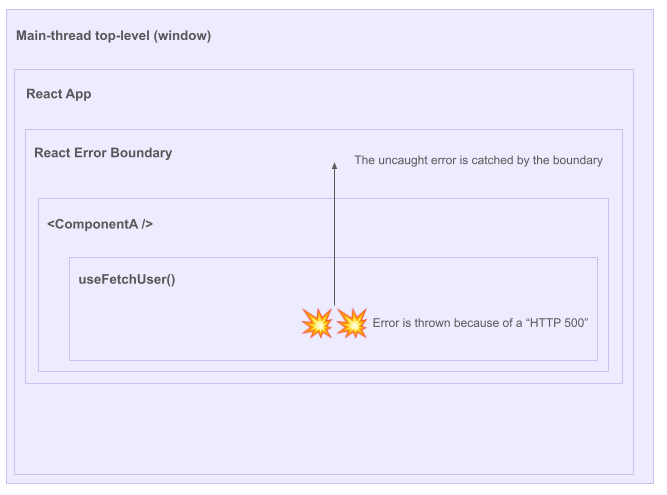Error boundaries introduced from React 16. This is the way to catch and handle JavaScript errors that occur in the React Components.
Error boundaries only catch errors that occur in a lifecycle method, render method, and inside Hooks like useEffect.
According to the React , error boundaries can't handle these errors
- Event handlers
- Asynchronous code
- Server-side rendering
- Errors thrown in the error boundary itself (rather than its children)
To Use an Error Boundary Feature Simply Create a Class Based Component
Our class component should also have at least three methods: 1. A static method called getDerivedStateFromError, which is used to update the error boundary’s state 2. A componentDidCatch lifecycle method for performing operations when our error boundaries catch an error, such as logging to an error logging service 3. A render method for rendering our error boundary’s child or the fallback UI in case of an error
import React from 'react';
export class MyAppErrorBoundary extends React.Component{
constructor(props){
super(props);
this.state = {hasError:false};
}
static getDerivedStateFromError(error) {
// Update state so the next render will show the fallback UI.
return { hasError: true };
}
componentDidCatch(error, info){
// used to log the error
console.log('Component Did Catch ::: Error Occur ', error, 'Info ',info);
//this.setState({hasError: true});
}
render(){
if(this.state.hasError){
return <h1 className="alert-danger">OOPS Something Went Wrong...</h1>
}
else{
return this.props.children;
}
}
}Error Propgate to the Errror Boundary.

To Use Error Boundary in App.jsx file
import logo from './logo.svg';
import './App.css';
import Home from './pages/Home';
import { MyAppErrorBoundary } from './shared/components/Error';
function App() {
return (
<MyAppErrorBoundary>
<Home/>
</MyAppErrorBoundary>
);
}
export default App;
Let's Generate Some Error and See the Effect.
import React from 'react'
import { useState } from 'react'
import Login from '../components/Login'
import Register from '../components/Register'
import { UserContext } from '../app/user-context'
const Home = () => {
const [screenFlag, setScreenFlag] = useState(true);
const [userInfo, setUserInfo] = useState();
throw new Error('Home Error...'); // Throwing Error From Here
const toggleIt = ()=>{
setScreenFlag(!screenFlag);
}
return (
<div className='container'>
<button className='btn btn-info' onClick={toggleIt}>{screenFlag?"Login":"Register"}</button>
<UserContext.Provider value={{user:userInfo,setUser:setUserInfo}}>
{screenFlag?<Login/>:<Register/>}
</UserContext.Provider>
</div>
)
}
export default HomeFinal Outcome if Error Generated..

That's All Folks , Happy Learning :)
